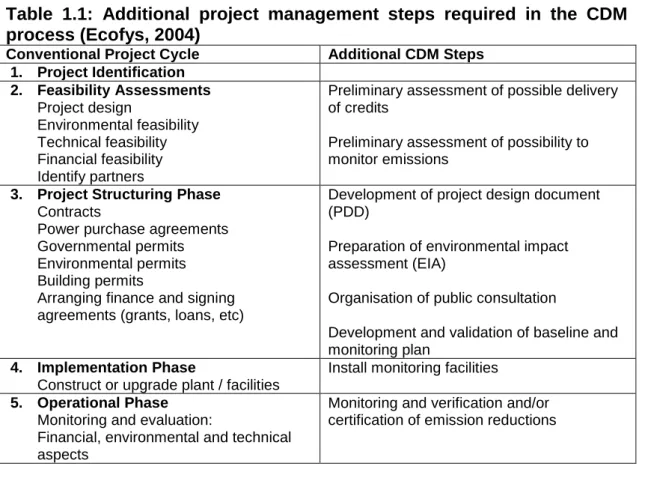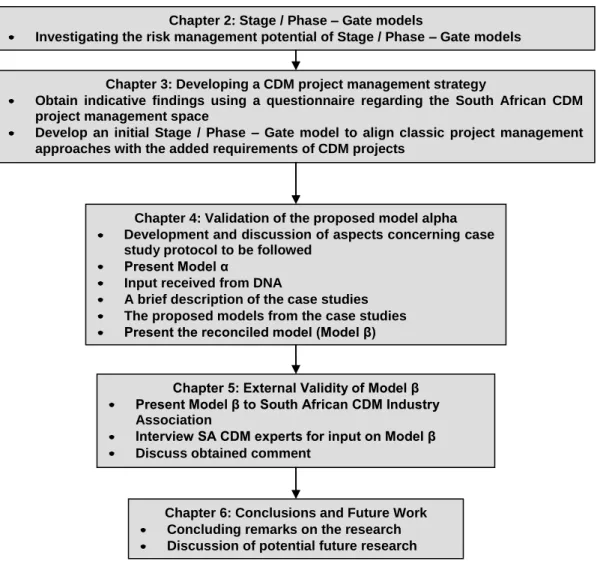During the investigation, aspects of the project management landscape of SA CDM projects were structured through a stage/phase and gate approach. Various research methods were used to develop the final proposed stage/phase and gate project management model (Model β). Interaction with the South African Clean Development Industry Association to validate the second version of the model.
In the end, there is no project as cumbersome and complex as the project management of children.
Introduction and background
Climate change and the Kyoto Protocol‟s Clean Development Mechanism (CDM) . 1
The CDM is governed by the Executive Board (EB) under the Kyoto Protocol, while trading of the CERs is facilitated by many entities, such as the World Bank's Carbon Finance Unit (2007). In this context, the baseline concept has a specific definition that implies "the scenario that reasonably represents the greenhouse gas emissions that would occur in the absence of the proposed project activity." – see Mizuno (2007). 1 In the CDM context, a methodology is a non-project specific guideline that must be met.
Only after the verification and certification by the DOE will the CDM issue EB CERs to the Project Proponent.
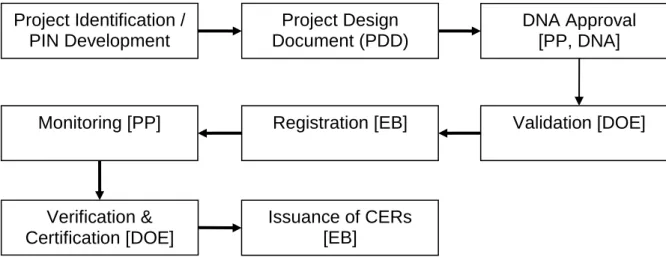
Rationale of the research
The "financial architecture" will either worsen or improve the ability of CDM projects to attract investment - see Moorcroft (2000) for further details. The greater the complexity, the lower the transaction flow. 2005) also raise transaction costs and lack of potential sustainable development benefits as reasons why emission reduction projects outside the CDM may be considered for African projects. 2005) indicated the complexities associated with sustainable development criteria for CDM projects specifically for South Africa. It is then the aim of this study to focus on CDM projects in Africa, and specifically South Africa.
This will be done by examining some aspects of the project management environment of CDM projects in South Africa.
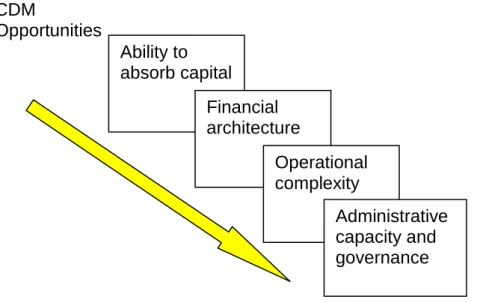
Related theory
In this study, the various historical attempts to examine the project management landscape and approaches to the CDM system will be grouped as indicated in Figure 1.4. One of the first comprehensive management approaches to CDM project management was developed by the European Bank for Reconstruction and Development (Ecofys, 2004). In the "Feasibility Assessment" phase, the applicability of the CDM to the proposed project must be investigated.
Another benefit of the software is that it also aims to help with portfolio management.
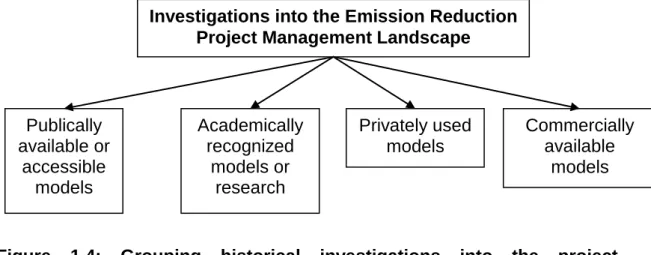
Problem Statement and Research Objectives
One of the aspects of these emission reduction projects that this research aims to address but cannot formally quantify is the rapid completion of the projects. To explore the benefits of an SA CDM specific project management framework for the successful implementation of emissions reductions. What is the interdependence of emission reduction project aspects such as technology, regulatory and economic issues.
The integrated approach to technical, regulatory and financial issues in emission reduction schemes adds a level of complexity to project management that is not commonly seen.
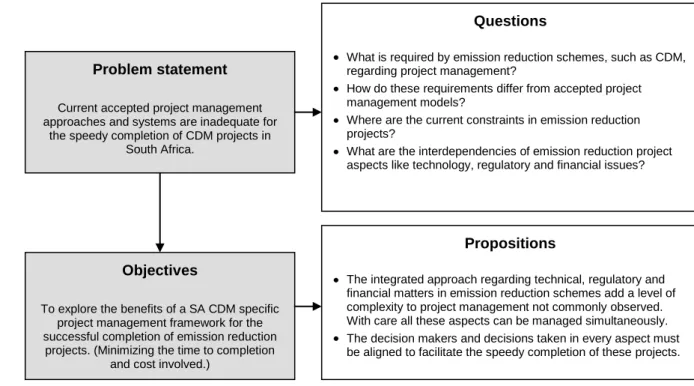
Benefits of aligning CDM project management with standard project lifecycle
Importance of the research problem
Limitations and assumptions of the study
The lack of peer-reviewed academic literature on the project management of emission reduction incentive projects specifically targeting Africa and South Africa. At the start of the study there were 10 registered projects in South Africa and this number grew to 17 at the end of the study. Proposed research approach and strategy The research approach is shown in Figure 1.6.
Proposed research approach and strategy
Investigating the risk management potential of a stage/phase-gate project
Introduction
The risk management benefits of such a phased/phased project management approach are much neglected in literature. The purpose of this chapter is to examine how a phased/phased project management approach can lower project risk. The risk management potential considered is both overall and within project phases by considering project life cycle phases as phases.
At a micro risk management level (the level of the nested stages/phases), each stage/phase of a project should contribute to systematically reducing the risk associated with a project.
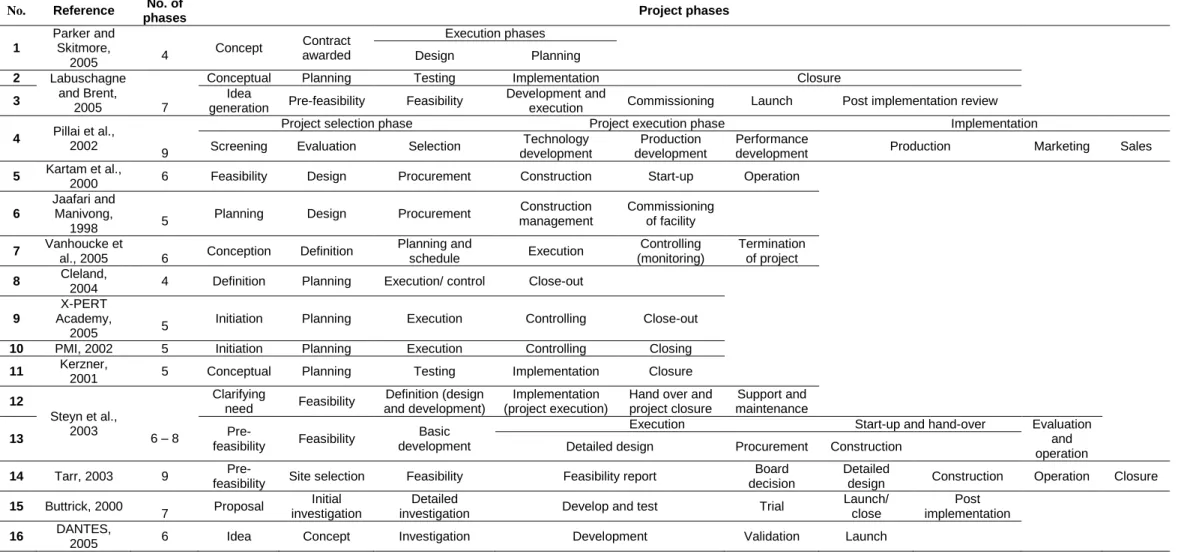
Project lifecycle stages and phases
A review should show that the phase's objectives and all criteria set for the phase have been met. Since the work done in one project phase typically provides more information, the overall plan for the rest of the project can be updated. The audit committee assesses the adequacy of the detailed planning for the next phase, the availability of resources, the risks involved and the feasibility of the rest of the project.
Passed – the objectives of the previous phase were met and it is decided to continue the specific project;.

The risk management potential of stage/phase-gate models
The uncertainties of the "amount at stake" monetary value must be established to determine the level of risk of the project. This view on risk is similar to that of the PMBOK (2004) where risk is defined as the probability that an event will occur and the consequence of such an event. On a micro risk management level, each phase/stage of a project should contribute to the systematic reduction of the risk associated with a project.
Despite recognizing the contribution that phases/phases and gateways make to empowering senior management and other stakeholders to control the project, and despite the fact that the goal of each phase should be to contribute to systematic risk reduction, the notion of phases /phases and Gates is still largely neglected in the project management literature.
An exploratory case study to illustrate the risk management potential of
The cost of the predictive control system available on the market was estimated at $1,200,000. Phase five was then the implementation of the new predictive control system in the new production facility. This new predictive control system required only one input variable compared to the twenty variables of the old predictive model.
The new predictive control system had predictive accuracy comparable to that of the old model;.
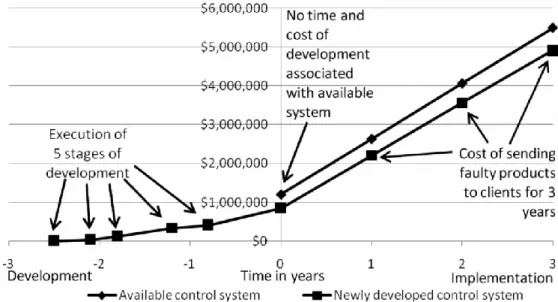
Chapter conclusions
Investigating the need for a Clean Development Mechanism (CDM) specific
- Introduction
- CDM opportunities for South Africa and Africa
- Engaging the South African CDM industry
- Proposed CDM project management model - Model α
- Layout transformation
- Model α layout transformation
- Further discussion and clarification of Model α
- Potential inefficiencies of the developed stage-gate Model α
Of the 156 projects submitted, 123 were Project Idea Notes (PINs) and 33 were Project Design Documents (PDDs). At the time of the investigation South Africa had a total of ten registered CDM projects verified by DNA (Department of Energy, 2010). Six of the eight respondents considered themselves partial to the technical and financial aspects of CDM projects compared to the regulatory aspects.
All five positive respondents concluded that the person/group acting as project manager succeeded in facilitating the development of the CDM projects. The South African specific emission reduction project environment was discussed with the founding members of the SA CDM IA;. As an example for logistical issues, a project closer to the resources of the project developer will be favored.
1 Clarify the need for the project. revenue / corporate responsibility / etc) 2 Make an initial assessment of emission reductions. This study will not contribute directly to these discussions, but the importance of the impact of price on the feasibility of an MDHK project should be emphasized. However, it should be noted that the accuracy of the ranking process will increase as the project progresses and the PDD develops.
Then, the model validation (chapter that follows) should determine whether all the criteria/components are required or whether other components need to be inserted. What the degree then actually achieves is the coordination of stakeholders and other parties involved during the development of the CDM project, and this is an advantage.
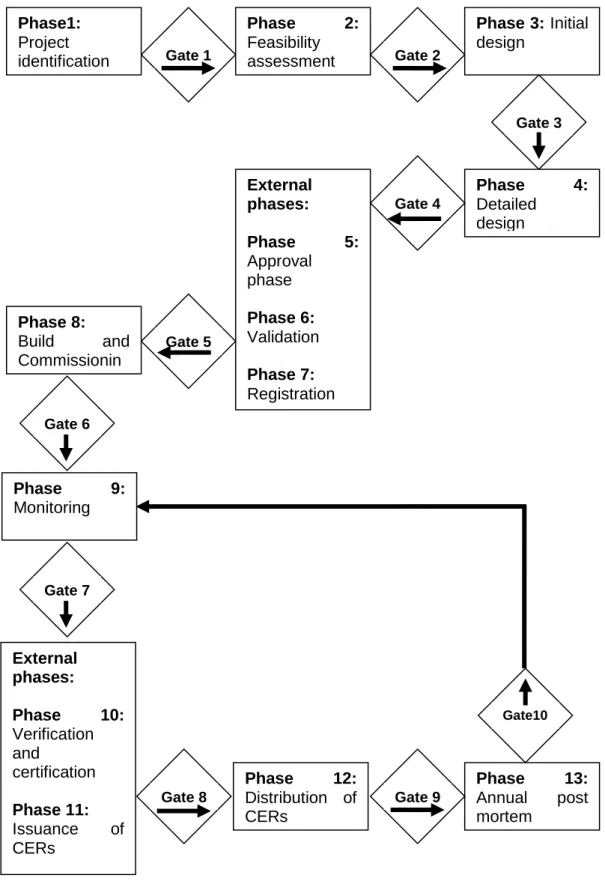
Validation of Model α
Introduction
Background on case study research
Case study approach
Discussion of case study protocol steps
Discussion of the proposed project management model of Case Study 1
Discussion of the proposed project management model of Case Study 2
Discussion of the proposed project management model of Case Study 3
Discussion of the reconciled model – Model β
Overall results, conclusions and next steps
External validity of Model β
Discussion on the answered questionnaires and identified trends
At the end of the 2nd round of questionnaires (July 2009), South Africa had 15 registered CDM projects (UNFCCC, 2009) as opposed to 101 registered CDM projects at the end of the 1st round of questionnaires (September 2007). Most of the respondents27 of the 2nd questionnaire indicated that they worked simultaneously on more than 10 CDM projects. This is more than the more than four CDM projects per respondent that resulted from the first questionnaire.
It is interesting to note that the location of current CDM efforts did not change at all. In the 1st and 2nd questionnaires it was found that 91% of the current focus was on South Africa. Furthermore, none of the respondents in the 2nd questionnaire had any plans for CDM efforts that were not based on the African continent.
It is interesting that the professionalism of the respondents of the 2nd questionnaire had the exact opposite assessment of professionalism compared to the 1st questionnaire. Out of 9 respondents, 8 (as opposed to 5 out of 8 in questionnaire 1) indicated that they have a dedicated person/group acting as project manager for CDM projects. Some of the questions in the questionnaire were aimed at identifying where CDM project developers and related parties perceived bottlenecks in the successful completion of a CDM project.
Given the fact that the respondents in the second questionnaire had the opposite specialty areas compared to the first questionnaire, it is important to note that the upper part of Table 5.2 still consists of the same components. The foreign CDM regulatory environment (UNFCCC related bodies) became stricter in implementing CDM rules and processes.

Experts‟ input on what is considered to be the success and failure criteria for CDM
Finally, Respondent 1 summarizes his/her experience by saying that the success of a CDM project strongly depends on the ability to anticipate pitfalls in the process and generate the paperwork to successfully overcome the pitfalls. Proof of additionality 3 Stage 1: C.1.2 Additonality is seen as a fundamental aspect of CDM and therefore falls under Stage 1: C.1.2 Sufficient ER. Good CDM Consultants 3 Unaddressed This model is to be applied by CDM developers and is not intended to judge the competence of the factory level people or support at any level.
3 Phase 1: C.1.2 Compliance with host country legislation is considered a cornerstone of the CDM and therefore falls under Phase 1: C.1.2. This management of expectations is particularly important considering that, according to respondent 7, the CDM process in Africa is still largely unknown.

Expert comment on the proposed CDM model (Model β) regarding applicability,
Conclusions and future work
Second, to ensure that the project activity contributed to the sustainable development of the host country.
Summary of Case study 2 (Energy efficiency)
This showed that the project developer wanted to use the methane for the best possible application. According to the PDD (ref), the Star Diamond Mine is located in an area rich in underground methane. The methane is believed to come from coal deposits found in the mined area.
Methane is a colorless and odorless explosive gas that has previously caused deaths in other mines in the region. In 2002, a methane explosion at the Star Diamonds mine resulted in the death of two miners. It was suggested that the sole purpose of this project activity is to destroy mine methane currently being vented to the atmosphere.
The project developer said that the amount of mine methane captured and vented to the atmosphere was not sufficient to justify the capital of electricity generation equipment. The Beatrix project is analogous to the Star Diamonds project in that the project aims to reduce methane emissions. This project differs from the Star Diamond project in that the project developer argues that the captured methane can be used as enough mine methane can be captured and controlled.
The technology used in the project activity will lead to a transfer of skills to the local mining employees. The findings of the DNA interview in relation to the Star Diamonds and Beatrix project are summarized in Table:.
